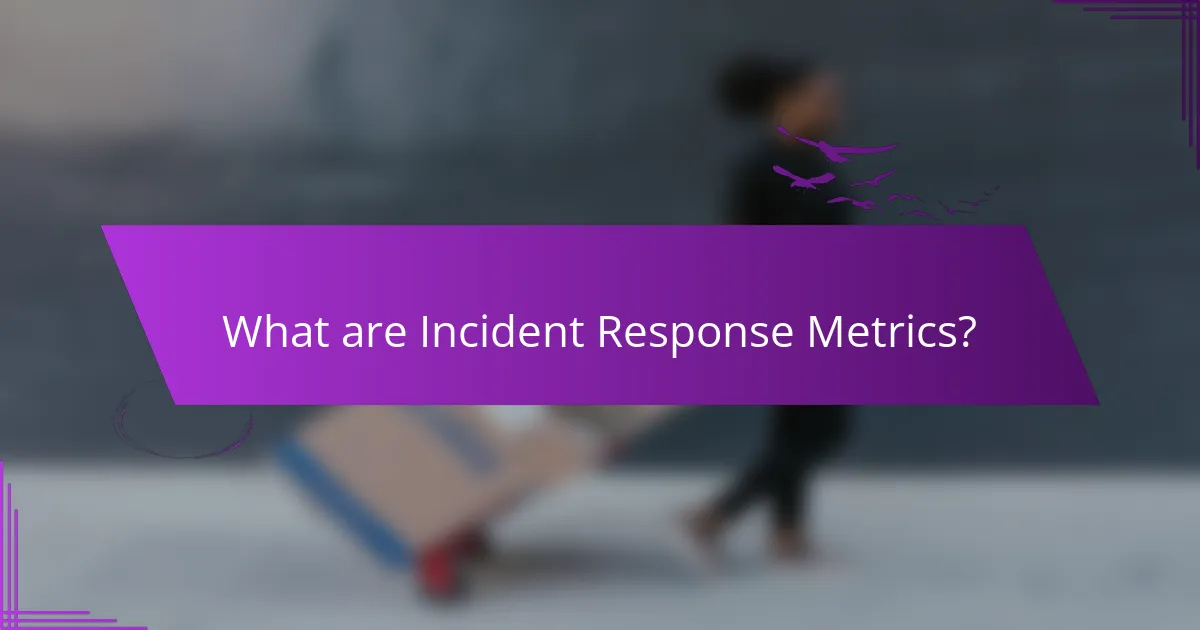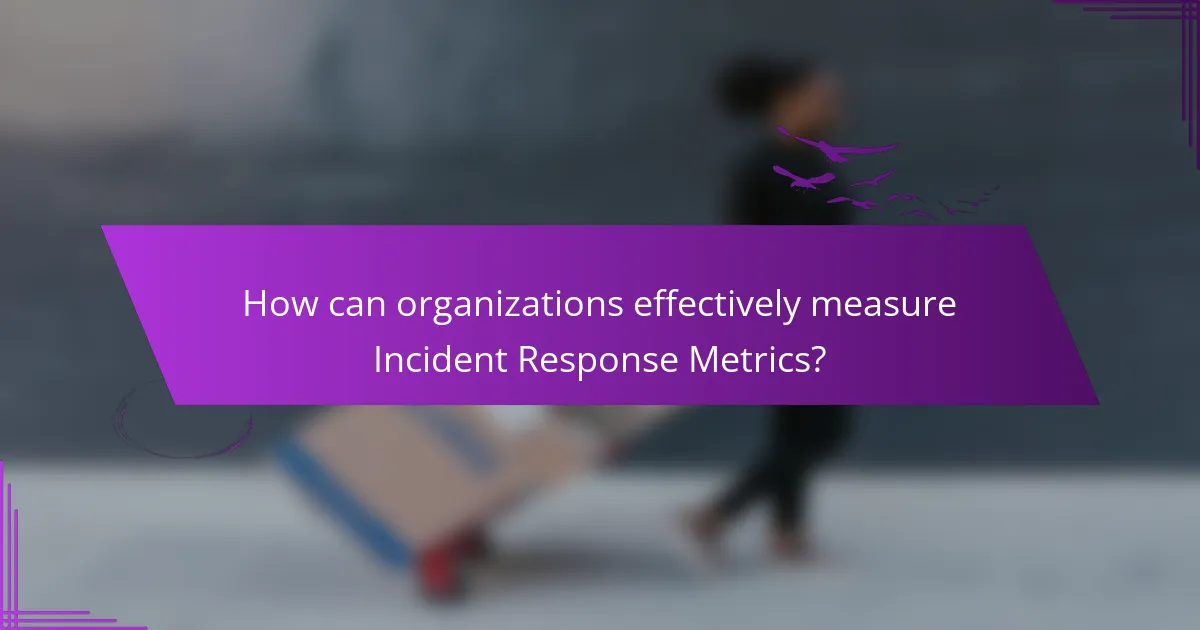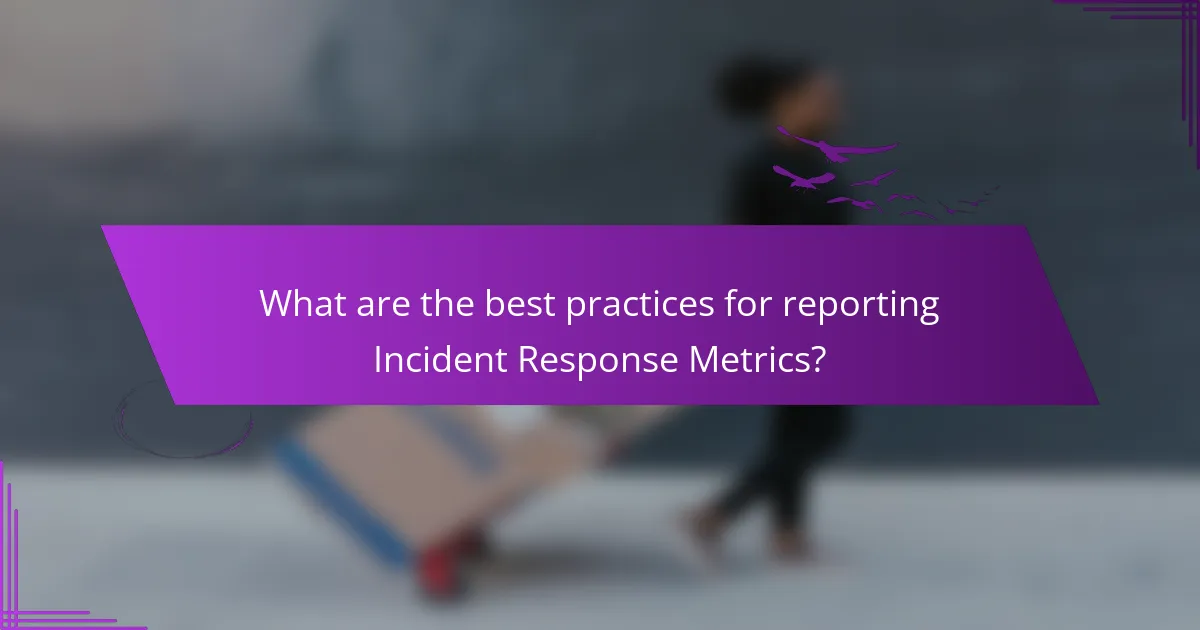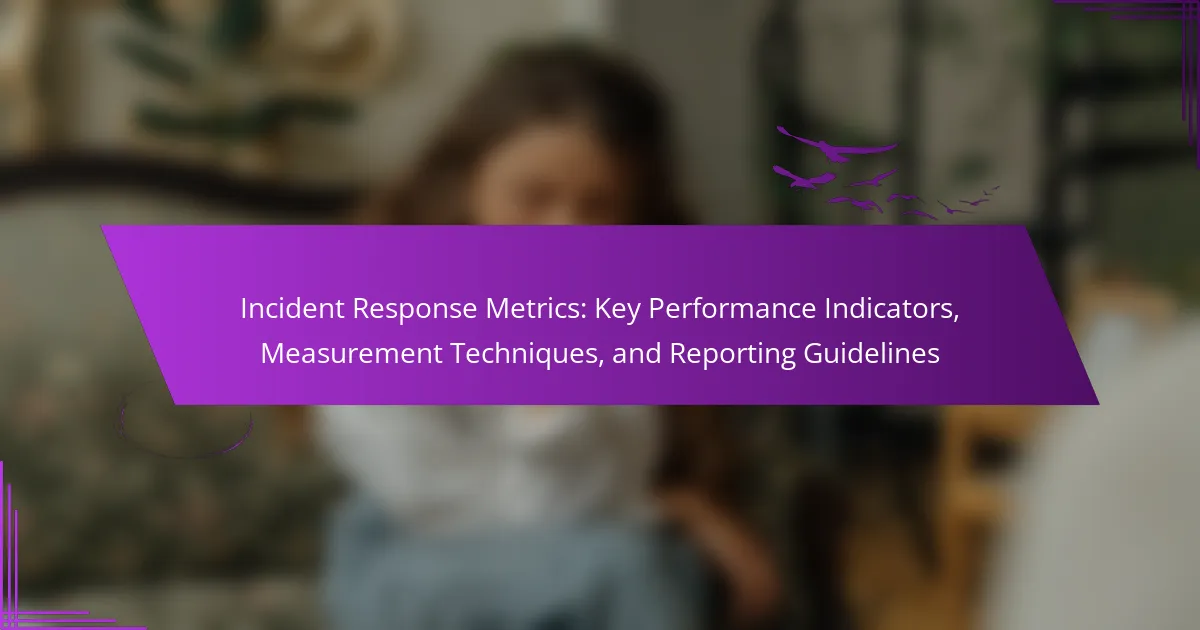
What are Incident Response Metrics?
Incident response metrics are quantitative measures used to evaluate the effectiveness of an organization’s incident response efforts. These metrics help track performance and identify areas for improvement. Common metrics include time to detect incidents, time to respond, and time to recover. For example, a study by the Ponemon Institute found that organizations with effective incident response teams can reduce the average time to detect a breach to less than 200 days. This data underscores the importance of establishing clear metrics for incident response. By analyzing these metrics, organizations can enhance their security posture and improve overall incident management.
Why are Incident Response Metrics important for organizations?
Incident Response Metrics are crucial for organizations as they provide measurable insights into the effectiveness of incident response efforts. These metrics help organizations identify weaknesses in their security posture. They enable teams to assess response times and the impact of incidents on business operations.
For instance, a report by the Ponemon Institute found that organizations with defined metrics can reduce their average incident response time by 30%. This reduction can significantly minimize potential financial losses and reputational damage. Furthermore, metrics facilitate continuous improvement by allowing organizations to refine their incident response strategies based on data-driven decisions.
By tracking specific KPIs, such as time to detect and time to contain incidents, organizations can enhance their overall cybersecurity resilience.
How do Incident Response Metrics impact overall security posture?
Incident response metrics significantly impact overall security posture by providing measurable insights into the effectiveness of security measures. These metrics help organizations identify weaknesses in their incident response processes. They also enable teams to evaluate the speed and effectiveness of their responses to security incidents. For example, metrics such as mean time to detect (MTTD) and mean time to respond (MTTR) quantify how quickly threats are identified and addressed. Organizations with lower MTTD and MTTR generally experience less damage from incidents, reinforcing their security posture. Furthermore, regular analysis of these metrics allows for continuous improvement in security strategies. This ongoing evaluation leads to better resource allocation and enhanced preparedness for future threats. Ultimately, effective use of incident response metrics results in a stronger, more resilient security posture.
What role do Incident Response Metrics play in compliance and risk management?
Incident Response Metrics are essential for ensuring compliance and managing risk effectively. They provide quantifiable data that helps organizations assess their incident response capabilities. By measuring response times, recovery times, and the number of incidents, organizations can identify areas for improvement. This data is critical for meeting regulatory requirements and industry standards. Effective metrics also facilitate risk assessment by revealing vulnerabilities and trends in incidents. Regular analysis of these metrics enables organizations to enhance their security posture. Furthermore, documenting metrics supports transparency and accountability in compliance audits. Overall, Incident Response Metrics are vital for aligning security practices with compliance obligations and risk management strategies.
What are the key components of Incident Response Metrics?
The key components of Incident Response Metrics include detection time, response time, containment time, and recovery time. Detection time measures how quickly an incident is identified. Response time tracks the duration from detection to the initiation of response activities. Containment time assesses how long it takes to limit the impact of the incident. Recovery time evaluates the duration to restore systems and services to normal operations. Each component is critical for evaluating the efficiency of incident response processes. These metrics help organizations improve their security posture and incident management strategies.
What are the essential Key Performance Indicators (KPIs) for incident response?
The essential Key Performance Indicators (KPIs) for incident response include Mean Time to Detect (MTTD), Mean Time to Respond (MTTR), and the number of incidents detected. MTTD measures the average time taken to identify a security incident. MTTR indicates the average time taken to resolve an incident after detection. The number of incidents detected reflects the effectiveness of monitoring systems. Additionally, the percentage of incidents contained within a specific timeframe is vital. These KPIs provide insights into the efficiency and effectiveness of an organization’s incident response capabilities. According to the Ponemon Institute’s 2021 Cost of a Data Breach Report, organizations with effective incident response plans can reduce the average cost of a data breach significantly.
How do different KPIs measure the effectiveness of incident response?
Different KPIs measure the effectiveness of incident response by quantifying specific performance aspects. Common KPIs include Mean Time to Detect (MTTD), which indicates the average time taken to identify an incident. Another important KPI is Mean Time to Respond (MTTR), measuring the time from detection to resolution. The number of incidents handled per analyst provides insight into team efficiency. Additionally, the percentage of incidents resolved within a predefined time frame reflects responsiveness. Customer satisfaction scores can gauge the perceived effectiveness of the response. These KPIs collectively offer a comprehensive view of incident response performance and areas for improvement.

How can organizations effectively measure Incident Response Metrics?
Organizations can effectively measure Incident Response Metrics by implementing a structured framework. This framework should include key performance indicators (KPIs) that reflect incident detection, response time, and resolution efficiency. Metrics such as Mean Time to Detect (MTTD) and Mean Time to Respond (MTTR) are essential. MTTD measures the average time taken to identify an incident. MTTR assesses the average time taken to resolve an incident.
Additionally, organizations should track the number of incidents detected, the severity of incidents, and the percentage of incidents resolved within predefined timeframes. Regular reviews of these metrics can help identify trends and areas for improvement. A study by the Ponemon Institute found that organizations with effective incident response metrics experience 50% fewer breaches. This emphasizes the importance of measuring these metrics accurately.
What measurement techniques are commonly used in incident response?
Common measurement techniques used in incident response include time to detection, time to containment, and time to resolution. Time to detection measures how quickly an incident is identified after it occurs. Time to containment assesses how long it takes to limit the impact of an incident. Time to resolution tracks the duration from detection to the complete resolution of the incident. Other techniques include the number of incidents handled, incident response cost, and user impact assessment. Each technique provides insights into the efficiency and effectiveness of the incident response process. These metrics help organizations improve their response strategies and resource allocation.
How do organizations collect data for Incident Response Metrics?
Organizations collect data for Incident Response Metrics through various methods. They utilize automated tools to gather information on security incidents. These tools can include Security Information and Event Management (SIEM) systems. SIEM systems aggregate and analyze log data from multiple sources. Organizations also conduct manual reviews of incident reports and logs. This helps to ensure accuracy and completeness of the data. Surveys and feedback from incident response teams provide qualitative insights. Additionally, organizations may leverage threat intelligence feeds for contextual data. According to a study by the Ponemon Institute, 54% of organizations use automated tools to collect incident data. This indicates a trend towards automation in data collection for incident response metrics.
What tools and technologies facilitate the measurement of Incident Response Metrics?
Tools and technologies that facilitate the measurement of Incident Response Metrics include Security Information and Event Management (SIEM) systems, incident response platforms, and automated reporting tools. SIEM systems aggregate and analyze security data from multiple sources. They provide real-time visibility into security incidents and help track response times. Incident response platforms streamline the incident management process. These platforms often include dashboards for monitoring key performance indicators (KPIs). Automated reporting tools generate detailed reports on incident handling and resolution times. They help organizations assess their response effectiveness. Additionally, threat intelligence tools can provide context for incidents, enhancing the measurement of response metrics. These tools collectively enable organizations to evaluate their incident response capabilities effectively.
How can organizations ensure the accuracy of their metrics?
Organizations can ensure the accuracy of their metrics by implementing rigorous data validation processes. Regular audits of data collection methods are essential. This includes verifying the sources of data and ensuring consistency in measurement techniques. Training staff on proper data entry and analysis is crucial for minimizing errors. Utilizing automated tools can enhance accuracy by reducing human error. Establishing clear definitions for each metric helps maintain uniformity in reporting. Additionally, cross-referencing metrics with external benchmarks can validate findings. Research shows that organizations with robust data governance frameworks report 20% higher accuracy in their metrics.
What best practices should be followed for data validation in incident response?
Best practices for data validation in incident response include establishing clear data collection protocols. Consistent data formats ensure accuracy and reliability. Implement automated validation tools to minimize human error. Regularly review and update validation criteria based on evolving threats. Ensure comprehensive logging of all validation processes for accountability. Conduct periodic audits to verify the integrity of the data. Training staff on data validation procedures enhances overall effectiveness. These practices lead to more reliable incident response metrics and improved decision-making.
How can organizations address common challenges in metric measurement?
Organizations can address common challenges in metric measurement by implementing standardized frameworks. These frameworks help ensure consistency in data collection and reporting. They should also invest in training employees on metric interpretation and usage. This training enhances understanding and improves decision-making based on metrics. Additionally, organizations must regularly review and adjust their metrics to align with evolving goals. This adaptability is crucial in dynamic environments. Utilizing automated tools for data gathering can minimize human error. Automation increases efficiency and accuracy in metric measurement. Finally, fostering a culture of transparency encourages open discussions about metrics. This culture can lead to better alignment and understanding across teams.

What are the best practices for reporting Incident Response Metrics?
Best practices for reporting Incident Response Metrics include defining clear objectives. Establish metrics that align with organizational goals. Use consistent data collection methods to ensure accuracy. Visualize data through charts and graphs for better comprehension. Regularly review and update metrics to reflect changing threats. Share reports with relevant stakeholders to enhance awareness. Ensure reports are actionable, providing recommendations based on findings. Lastly, maintain documentation for transparency and future reference.
How should Incident Response Metrics be communicated to stakeholders?
Incident Response Metrics should be communicated to stakeholders through clear and concise reporting. Utilize visual aids like graphs and charts to enhance understanding. Tailor the communication style to the audience’s technical expertise. Regular updates should be scheduled to maintain engagement. Include key performance indicators that align with business objectives. Use language that is straightforward and avoids technical jargon when possible. Ensure metrics are contextualized with relevant incidents for clarity. Provide actionable insights based on the metrics to drive informed decision-making.
What formats are most effective for presenting Incident Response Metrics?
Visual formats such as dashboards and charts are most effective for presenting Incident Response Metrics. Dashboards provide real-time data visualization, making it easy to identify trends and anomalies. Charts, including bar and line graphs, simplify complex data into understandable visuals. Tables can also be useful for detailed comparisons but may not convey insights as quickly as visuals. Infographics can summarize key metrics in an engaging manner. According to a study by the SANS Institute, effective visualization enhances data interpretation and decision-making in incident response.
How can organizations tailor reports for different audiences?
Organizations can tailor reports for different audiences by identifying the specific needs and interests of each audience segment. They should analyze the audience’s level of expertise and familiarity with the subject matter. For technical teams, detailed data and metrics are essential. Non-technical stakeholders may require high-level summaries with actionable insights.
Using clear and relevant visuals can enhance understanding for all audiences. Organizations should also customize the language used, avoiding jargon for general audiences while employing technical terms for specialists. Additionally, presenting data in context helps audiences grasp the implications of the metrics.
Regular feedback from audience members can inform adjustments in future reports. This approach ensures that the reports remain relevant and effective in communicating key information.
What common pitfalls should be avoided when reporting Incident Response Metrics?
Common pitfalls to avoid when reporting Incident Response Metrics include unclear definitions of metrics. Vague metrics can lead to misinterpretation of data. Another pitfall is failing to align metrics with business objectives. Metrics should reflect the organization’s goals for effective communication. Additionally, overcomplicating reports can confuse stakeholders. Simplified metrics enhance understanding and decision-making. Ignoring context is also a mistake. Providing context helps stakeholders grasp the significance of the metrics. Lastly, not tracking trends over time can obscure performance improvements or declines. Consistent tracking allows for better strategic planning and resource allocation.
How can organizations ensure clarity and relevance in their reports?
Organizations can ensure clarity and relevance in their reports by following structured guidelines. They should define clear objectives for each report. This helps in aligning content with the intended audience’s needs. Using straightforward language enhances understanding. Visual aids like charts or graphs can simplify complex data. Consistent formatting aids in navigation and comprehension. Regularly reviewing and updating reporting standards keeps the information current. Feedback from report users can identify areas for improvement. These practices lead to more effective communication of incident response metrics.
What strategies can be employed to improve stakeholder engagement with reports?
To improve stakeholder engagement with reports, organizations can implement several strategies. First, tailor reports to meet the specific needs of different stakeholders. This ensures relevance and increases interest. Second, utilize clear and concise visuals such as charts and graphs. Visuals enhance comprehension and retention of information. Third, encourage feedback through interactive sessions. Engaging stakeholders in discussions fosters a sense of ownership. Fourth, provide summaries that highlight key findings. Summaries allow stakeholders to grasp essential information quickly. Fifth, schedule regular updates to maintain ongoing communication. Consistent updates keep stakeholders informed and engaged over time. Finally, incorporate storytelling techniques to make data relatable. Storytelling can transform complex metrics into compelling narratives. These strategies collectively enhance the connection between stakeholders and the reports provided.
What are some practical tips for enhancing Incident Response Metrics?
To enhance Incident Response Metrics, organizations should establish clear definitions for each metric. This clarity ensures consistent measurement and reporting. Regularly review and update these metrics to align with evolving threats and business objectives. Implement automated tools for real-time data collection and analysis. Automation reduces human error and increases efficiency. Conduct regular training sessions for incident response teams to improve their skills. Trained personnel can respond more effectively to incidents. Utilize benchmarking against industry standards to evaluate performance. This practice provides context for improvement. Finally, ensure metrics are actionable and tied to specific response strategies. Actionable metrics drive meaningful improvements in incident response.
Incident Response Metrics are quantitative measures that evaluate the effectiveness of an organization’s incident response efforts, focusing on key performance indicators (KPIs) such as Mean Time to Detect (MTTD) and Mean Time to Respond (MTTR). This article outlines the importance of these metrics in enhancing security posture, ensuring compliance, and facilitating risk management. It also discusses measurement techniques, data collection methods, and best practices for reporting and communicating these metrics to stakeholders. By implementing effective metrics, organizations can improve their incident response strategies and overall cybersecurity resilience.
